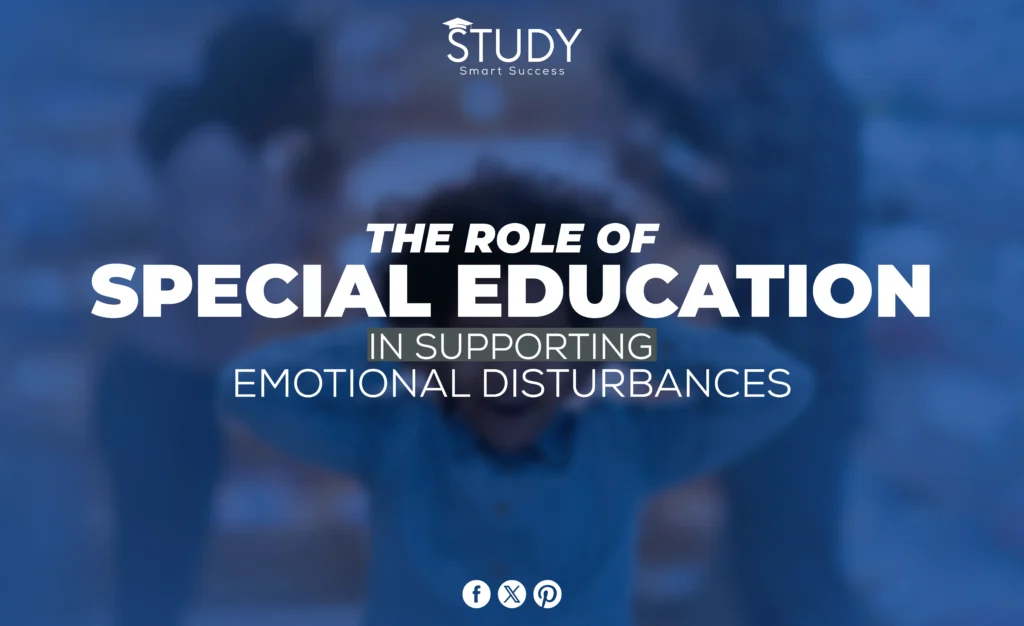Introduction
Emotional disturbances (ED) in special education are conditions that impair a child’s educational performance over time and to a significant degree: an inability to learn that cannot be explained by intellectual, sensory, or health factors; a failure to build or maintain satisfactory interpersonal relationships with peers and teachers; inappropriate behavior or feelings under normal circumstances; a general mood of unhappiness or depression; or a tendency to develop physical symptoms or fears associated with personal or school problems.
Addressing emotional disruptions in schools is essential for several reasons. It ensures all students, including those with ED, have a fair chance to achieve and promotes a supportive and inclusive learning environment. Early identification and treatment of these individuals can improve their academic performance and mental health.
This blog article discusses how special education helps ED students. This post aims to illuminate the unseen battles in classrooms nationwide and emphasize the importance of specialized interventions for students with emotional disturbances by describing their challenges and how educators can help them.
Understanding Emotional Disturbances
Definition and Characteristics of ED
The Individuals with Disabilities Education Act (IDEA) says that Emotional Disturbance (ED) is a condition in which a child shows one or more specific emotional or behavioral traits over a long period and to a noticeable degree, which hurts their academic success.
Characteristics:
- Inability to Learn: This isn’t caused by intellectual, sensory, or health issues, but it is a big problem for kids with ED that makes it harder for them to do well in school.
- Interpersonal Difficulties: It can be challenging for students with emotional disturbance to make and keep good ties with teachers and peers, which can cause them to feel alone and cause problems.
- Inappropriate Behavior: They might misbehave daily, like throwing extreme temper tantrums, getting angry, or pulling away.
- Mood Disturbances: People with this condition often feel sad all the time, which makes them less motivated to do schoolwork and other activities.
- Physical Symptoms: They often get physical symptoms or fears when they are having problems at home or school, which shows that their mental problems are psychosomatic.
Common Challenges Faced by Students with ED in Traditional Educational Environments
In standard school settings, students with emotional problems often face a variety of issues that can make it harder for them to learn and make friends. Here are some of these problems:
- Limited Understanding and Awareness: Peers and teachers who don’t know much about emotional problems make it easier for students with ED to be judged and misunderstood for the behaviors they show.
- Inadequate Support Services: Schools may not have enough support services and tools to meet the specific needs of students with ED, making it hard for them to grow academically and emotionally.
- Difficulty in Curriculum Accessibility: Because of their emotional or behavioral problems, students with ED may be unable to access the curriculum like their peers. This means that they need accommodations that aren’t always accessible.
- Social Isolation: Since students with ED often have trouble making and keeping friends, they end up being socially isolated, which makes their mental problems worse.
- Behavioral Misinterpretation: Behaviors caused by mental problems are sometimes mistaken for disobedience or lack of interest, leading to punishments that aren’t always the best way to deal with the situation.
- Transition Challenges: Because things must be consistent and predictable, these students may have difficulty moving from one activity, grade, or school level to another.
Impact of Untreated Emotional Disturbances on Academic, Social, and Emotional Development
If you don’t treat emotional problems (ED), they can have effects outside of school that hurt your child’s academic, social, and emotional growth. Some significant effects are:
- Academic Underperformance: Students with untreated ED are more likely to have trouble in school, which can show up as bad grades, repeated grades, and a higher rate of dropping out than their peers who don’t have ED.
- Social Stigmatization: Peers and sometimes teachers can make fun of students with ED because they don’t get enough help and understanding. This social stigma can make students feel even more alone, making connecting with others harder.
- Increased Behavioral Issues: Students with ED may act out more, like being angry, withdrawing, or hurting themselves, if they don’t get the help they need to deal with their feelings and the demands of their surroundings.
- Mental Health Decline: Students with ED who don’t get help for it may develop anxiety, depression, and other mental health issues because of the stress and problems they have to deal with every day.
- Reduced Opportunities for Success: Academic problems, social isolation, behavior problems, and a decrease in mental health can all make it much harder to succeed in school, work, and personal growth in the future.
To keep these long-term problems from happening and to help students with mental issues grow into strong, self-confident adults, it is essential to understand and meet their specific needs.
Special Education Interventions for Emotional Disturbances
Individualized Education Program (IEP)
Role of the IEP in addressing the unique needs of students with ED
The Individualized Education Program (IEP) is essential for students with emotional disorders. It tailors educational planning and interventions to each student’s requirements, creating a more supportive and effective learning environment. The IEP strives to improve ED kids’ academic achievement, emotional regulation, and social interaction by understanding their particular problems and capacities.
Components of an effective IEP for students with emotional disturbances
A full assessment of ED children’s strengths, limitations, and emotional and behavioral needs is needed for an effective IEP. It comprises clear educational goals, unique instructional methodologies, accommodations, and curriculum adaptations where needed. It also lists counseling, speech-language therapy, and social work programs to help students emotionally and academically.
Behavior Intervention Plans (BIP)
Purpose and implementation of BIPs in managing challenging behaviors
Strategic and customized conduct Intervention Plans (BIPs) address emotional problems in children’s conduct. BIPs identify the reasons for problematic behaviors and develop measures to reduce or eliminate them, boosting student engagement in learning. Proactive behavior management is achieved through systematic observation, data gathering, and instructor involvement with BIPs.
Collaborative approach involving educators, parents, and mental health professionals
Education, parents, and mental health experts must work together to create and implement a BIP. This team-based approach ensures a complete grasp of the student’s needs and uses many viewpoints to construct a successful and sustainable plan. By working together, stakeholders may provide consistent interventions at home and school, promoting students’ emotional and behavioral growth.
Social and Emotional Learning (SEL) Curriculum
Importance of SEL in fostering emotional regulation and interpersonal skills
Students with emotional issues need SEL throughout the curriculum. SEL develops emotional regulation, empathy, connection building, and responsible decision-making. Students with ED need these skills to manage their emotions, build healthy relationships, and make responsible choices.
Integrating SEL into daily instruction through evidence-based practices
Giving students real-life opportunities to practice social and emotional skills, creating a safe and supportive learning environment, and modeling positive conduct are evidence-based ways to include SEL in daily instruction. Teachers can also use SEL-specific curricula or alter lesson plans to teach SEL concepts like emotional awareness, problem-solving, and social awareness.
Creating Supportive Learning Environments
Positive Behavior Supports (PBS)
Implementing proactive strategies to promote positive behavior
Positive Behavior Support (PBS) uses clear expectations, teaches acceptable behaviors, and recognizes and reinforces them to promote positive behavior. This strategy prevents behavioral issues and helps pupils with emotional challenges by providing a controlled and predictable atmosphere.
Creating a supportive and inclusive classroom culture
A supportive and inclusive classroom culture is essential to PBS. This requires developing a sense of belonging for all kids, fostering peer respect and understanding, and adjusting teaching techniques to various learners. A positive classroom culture eliminates exclusion and stigma, making emotional disturbances kids feel respected and supported.
Trauma-Informed Practices
Recognizing the impact of trauma on students with ED
Trauma-informed practices recognize that trauma can profoundly impact the emotional disturbance of students’ learning, conduct, and relationships. This type of educator recognizes trauma and how it can cause or worsen emotional and behavioral issues.
Implementing trauma-informed approaches to support healing and resilience
Trauma-informed techniques adjust educational environments and instruction to promote healing and resilience. Students may benefit from safe environments, flexible learning tasks, and restorative conflict resolution. These methods acknowledge students’ experiences and help them cope with stress and trauma.
Collaboration with Mental Health Professionals
Importance of interdisciplinary collaboration in supporting students with ED
Educators, mental health specialists, and even medical staff must work together to support emotionally disturbed students. Collaboration ensures consistent and high-quality student care, holistically addressing their educational and emotional needs.
Providing access to counseling, therapy, and other mental health services within the school setting
Students with emotional issues need school-based mental health treatments. School-based counseling, therapy, and other mental health services give pupils direct support. This access benefits students and educators by providing more resources and ways to help students achieve.
Challenges and Future Directions
Persistent Challenges in Supporting Students with ED in Educational Settings
Limited resources and funding
Due to inadequate resources and financing, many educational systems struggle to help students with emotional disorders (ED). This scarcity hinders staff-to-student ratios, mental health professional access, and student-specific activities.
Addressing stigma and misconceptions surrounding mental health
Supporting emotionally disturbed kids is hampered by stigma and misconceptions about mental health. Such attitudes may prevent educators, parents, and peers from helping students with these issues, isolating and worsening the situation.
Navigating the complexities of individualized education plans (IEPs)
Developing and implementing effective IEPs for emotionally disturbed students is challenging. These plans need educators, mental health specialists, and families to learn about each student’s needs, strengths, and weaknesses and to change and collaborate. This process must be completed successfully for ED kids to receive the personalized support they need to succeed in school.
Future Directions for Improving Special Education Support for Students with Emotional Disturbances
Advocating for increased funding and resources
Advocating for local and national funding and resources for ED students is essential. Funding can expand specialized programs, provide skilled personnel, and create inclusive educational materials and procedures.
Promoting professional development and training for educators
To effectively serve students with emotional disorders, educators need professional development and training. This involves moving and behavioral intervention training, trauma awareness, and inclusive and adaptable teaching practices.
Leveraging technology to personalize learning experiences
Technology in the classroom can personalize teaching for emotionally disturbed students. Individualized learning routes, interactive material, and social-emotional learning platforms can be created using digital tools and resources. By adequately integrating technology, educators can boost engagement, motivation, and accessibility, making ED learning more supportive and successful.
Conclusion
This conversation has highlighted the importance of special education for emotionally disturbed students. These children’s holistic development and academic success depend on personalized educational methods, trauma-informed practices, and educator-mental health specialist collaboration. Meeting the particular needs of ED students is a moral and intellectual obligation that impacts their learning, emotional well-being, and prospects.
Collaboration between educators, governments, and communities is necessary to build on progress and address ongoing difficulties. We must promote increased school financing for special education and mental health. Effective teacher emotional disturbance training improves learning settings. Every stakeholder must recognize mental health support in education and promote diversity.
Making emotionally disturbed children’s schools more inclusive and supportive continues. They need tolerance, understanding, mental wellness, and academic success strategies. Building such spaces shows we value and empower all students. Our commitment will improve the lives of ED students and enrich the school community, helping all children achieve despite emotional problems.


